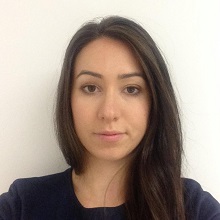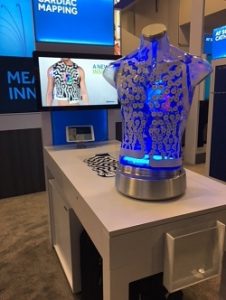
One of the fantastic things about working as a researcher is the opportunities to travel and meet people. When I announced to colleagues and friends that I was going to San Francisco for work, there was definitely an air of “Oh yes? How convenient!”, as if I’d chosen a holiday destination and planned a work trip around it! However this year, the Heart Rhythm Society
Scientific Sessions annual conference was to be held in San Francisco, and as a researcher looking at how to improve the treatment of heart rhythm disorders, this was definitely an opportunity not to be missed.
The conference (known as HRS), was held at the Moscone Convention Center in downtown San Francisco on the 8th-11th May 2019. It was the biggest conference I have been to with over 13,000 delegates, 200 educational sessions, and about 25000m² of exhibition space; plenty of opportunity for learning and meeting new people. This year was the 40th anniversary of HRS Sessions, and the organising committee clearly wanted to celebrate its history. The meeting kicked off with a session chaired by Guy Raz, the journalist and host of the podcast “How I Built This”, telling the story of HRS. He told of how HRS started off life as the North American Society for Pacing and Electrophysiology (NASPE), with about 20 people attending the first meeting. Cardiology was a very different discipline in the 1980s. The first implantable cardioverter defibrillator (ICD) device used to shock a patient out of an abnormal rhythm was implanted in a human, 20 years prior the first pacemaker was implanted, and catheter ablation therapy (in which a catheter is temporarily inserted in the heart in order to make changes to the structure of the tissue) now commonly used to treat rhythm disturbances was yet to be developed. Guy introduced a number of key cardiologists and Society Presidents who have been instrumental in the development of the field over the last 40 years, and looked forward to the potential advancements which may come about in the next 40 years. It seems that the field of cardiology has its eye on harnessing data from wearable technology to observe people’s heart rhythms as they go about their daily life, and artificial intelligence being used to guide robotic surgical devices. Perhaps what was missing from this prognosis and lacking in the content of the meeting as a whole, was the consideration of prevention strategies.

The sessions that took place during the meeting covered everything from basic science, through to clinical care and healthcare policy. They were long days, often starting at 7am and not finishing until 9pm. I focussed on attending sessions which I would learn the most from and which could be useful for my research on developing methods to guide catheter ablation therapy used to treat abnormal heart rhythms as a result of damage caused by a heart attack. Therefore, I attended many sessions focussed at cardiologists, in order to gain insight into clinical practice. These sessions involved learning how to interpret electrical recordings of the heart beat (ECG) to detect abnormal heart rhythms or arrhythmias, and learning about the many aspects of catheter ablation, from diagnosis, through to procedure protocol, and patient care. Throughout the conference there was quite a focus on imaging techniques to look at the structure of the heart. I was interested in these sessions because much work is being done on developing new techniques to observe the fine-scale damage caused by a heart attack which underlies dangerous arrhythmias. Being able to pin-point the region of the heart which is damaged and responsible for causing arrhythmias is perhaps one of the greatest challenges in the ablation treatment, and one which I focus on in particular. Of great interest to me was a session titled “How today’s scientific innovations will transform tomorrow’s arrhythmia treatments”. This session involved talks about novel methods to locate damage within the heart, novel methods for delivering therapy to the specific site more effectively, and how computational models may be used in therapeutic protocol. Alongside these sessions, hundreds of posters were presented each day which provided the opportunity to meet other researchers and hear about the vast variety of work being conducted in this field around the world.
In addition to the educational sessions and posters, the exhibition halls were filled with elaborate stands from leading medical devices companies such as Biosense Webster, Abbott and Medtronic. Their impressive stands displayed the latest catheters, implantable devices and medical mapping software which cardiologists use in ablation procedures. Particularly eye-catching was a new electrode vest developed by Medtronic which records electrical activity signals from the heart from 256 locations across a patient’s chest. Other exhibits had dummy patients which you could insert catheters into to test out new catheters and mapping software! It was striking to see the variety of products that do similar things, which cardiologists have to choose between, in addition to the amount of money that is clearly involved in the healthcare technology industry.
International conferences provide fantastic opportunities to meet new colleagues and researchers. I met many people at their posters who used techniques which could potentially be applied to my research, and many cardiologists who have similar research interests, who may be interested in working together on projects in the future. It’s important to follow up on these connections made and keep in contact. You never know what might come of these meetings! Conferences are also a change to meet people in your existing network and strengthen these connections. On this trip I bumped into my industrial contacts at Biosense Webster and we were able to discuss new avenues for our existing project. I caught up with old colleagues and friends from King’s College London and heard about the continuing work that I was involved with during my PhD. It was wonderful to see my PhD viva examiner who is working on a variety of projects related to my own, and so we were very interested in discussing our findings and potential new avenues to study. I also ran into a fantastic colleague and esteemed Professor working in cardiac modeling, who gave a talk at a workshop that I ran last year. It was great to experience the interactions between people with common interests and the shared goal of improving the treatment of cardiac arrhythmias, as well as to see that even the most highly respected amongst the field were feeling slightly overwhelmed by the information overload and the scale of the meeting!
It would be remiss not to mention that I took the opportunity to see some of the sights of the Bay Area over the course of my trip. What struck me was the diversity of the region. Within an hour’s drive, you could see a bustling city centre with its shopping districts, financial centre, and history of the industrial Fisherman’s Wharf. The Island of Alcatraz was a short boat trip away and you could walk around the notorious penitentiary which has been transformed into a tourist attraction and botanical garden! There were the affluent suburbs with views of the Pacific Ocean, Golden Gate Bridge and the very impressive Golden Gate Park (including Bison!). There were also the not so affluent sprawling suburbs which have sprung up to provide housing for the workers who are involved in farming the vast Central Valley region of California. A real highlight of the region was the scenic Sierra Nevada mountain range which I saw on the way to the magnificent Yosemite National Park with its many waterfalls, mountains and redwood forests.

The whole trip was a fantastic experience for me both professionally and personally. I learnt a great deal and met some interesting people, both of which will be invaluable to my research project. Here are some interesting memos that I took away:
- Making connections with people is at the very heart of a successful research culture and should be a foundation that early career researchers like myself should look to build.
- At points, I noticed a significant gender imbalance in the audience and chairpersons at the meeting and as such it is important to bear in mind that working towards gaining equality in the science and medicine workforces, so that all members of our society are equally represented, is as important now as it ever was.
- Lastly, with the incredible advances in our understanding of arrhythmias, new medical equipment, imaging modalities, and therapeutic care, it is becoming easier to treat cardiac arrhythmias. However, it is obvious that research is required to address the challenges that clinicians still face. For example, one clear message from the conference is that we need to improve on methods to locate the regions of damaged tissue which cause certain types of arrhythmia. Whilst the treatment of arrhythmias is improving, it is important to note that they often involve invasive procedures and in some cases, cause irreparable damage to the heart. Therefore, I believe it will be important to focus efforts on prevention strategies and novel non-invasive therapy in the future.